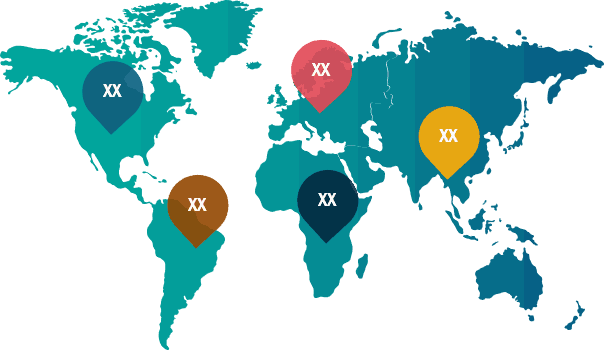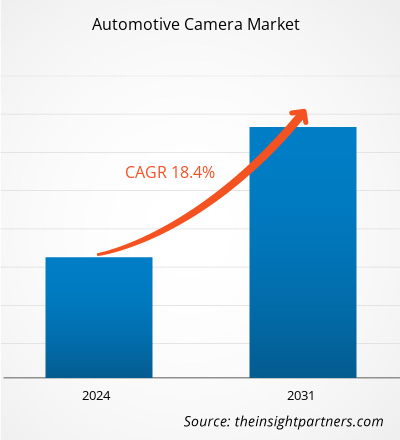汽车摄像头市场规模预计将从2023年的97.0457亿美元增至2031年的374.3672亿美元。预计2023-2031年市场复合年增长率为18.4%。对安全性的日益关注和电动汽车销量的增加可能仍然是市场的主要趋势。
车载摄像头市场分析
汽车摄像头市场的主要终端用户包括戴姆勒公司、塔塔汽车、Eicher Motors、Hindustan Motors、丰田、大众、福特汽车等汽车制造商。这些公司生产商用车和乘用车,其中这些公司为其车辆采购汽车摄像头,然后再交付给客户。因此,未来几年乘用车和商用车需求的增长预计将推动预测期内汽车摄像头市场的发展。
车载摄像头市场概况
全球车载摄像头市场生态系统的主要参与者包括原材料供应商、车载摄像头制造商、整车厂和最终用户。原材料供应商是车载摄像头市场生态系统中的重要利益相关者。主要原材料是玻璃、萤石、石英玻璃、氟化物和塑料,其中锗、丙烯酸和陨石玻璃是制造汽车摄像头的常用原材料。主要原材料供应商包括Dynaflex Corporation、Ohara Corporation、AGC Inc.、SCHOTT、Canon Inc.、Universe Kogaku (America) Inc.、Sunex Inc.等。因此,越来越多的原材料供应举措正在加强汽车摄像头的生产,从而推动市场增长。
定制研究以满足您的要求
我们可以优化和定制我们的标准产品无法满足的分析和范围。这种灵活性将帮助您获得业务规划和决策所需的准确信息。
汽车摄像头市场:

年均复合增长率(2023 - 2031)18.4%- 2023 年市场规模
97.0457 亿美元 - 2031年市场规模
374.3672亿美元

市场动态
- 车辆中越来越多地采用先进摄像头
- 电动汽车需求不断增长
- 高级驾驶辅助系统 (ADAS) 的使用激增
关键人物;主力;重要一员
- Surefly 合作伙伴有限公司
区域概况

- 北美
- 欧洲
- 亚太
- 南美洲和中美洲
- 中东和非洲
市场细分
 应用
应用- 停车辅助系统和 ADAS
 类型
类型- 黑白相机
- 环视摄像机
- 后视摄像头
 车辆类型
车辆类型- 乘用车和商用车
 自主程度
自主程度- L1
- L2
- L3
- 其他的
- 示例 PDF 通过定性和定量分析展示了内容结构和信息的性质。
汽车摄像头市场驱动因素和机遇
车辆中越来越多地采用先进摄像头以利于市场
汽车摄像头系统在最近的应用中发挥着至关重要的作用,包括前向碰撞警告系统、盲点警告和车道偏离警告系统。高端摄像头可以植入先进的计算机视觉算法,用于高级驾驶员辅助系统的真实机器视觉系统。因此,摄像头在汽车中的应用的鼓励和技术发展的进步推动了先进摄像头在汽车中的采用。
电动汽车需求不断增长
化石燃料造成的日益严重的环境污染是政府关注的主要问题之一。为了降低环境污染水平,各国政府通过给予特别的销售回扣、奖励、利润丰厚的优惠和税收优惠等方式,强调消费者在日常生活中采用更清洁、可持续和环境友好的替代品。中国、日本、欧盟、印度、加拿大和韩国等主要地区的政府正在积极努力促进乘用电动汽车的采用,预计这将在预测中推动汽车摄像头市场的发展时期。
汽车摄像头市场报告细分分析
有助于得出汽车摄像头市场分析的关键部分是应用、类型、车辆类型和自主水平。
- 根据应用,汽车摄像头市场分为以下两类:停车辅助系统和ADAS系统。 2023 年,停车辅助细分市场将占据更大的市场份额。
- 根据类型,车载摄像头市场分为单色摄像头、环视摄像头和后视摄像头。到2023年,后视摄像头细分市场将占据更大的市场份额。
- 根据车辆类型,车载摄像头市场分为乘用车和商用车。 2023年,乘用车细分市场将占据更大的市场份额。
- 根据自主级别,车载摄像头市场分为L1、L2、L3等。 2023 年,L1 细分市场将占据更大的市场份额。
按地区划分的汽车摄像头市场份额分析
汽车摄像头市场报告的地理范围主要分为五个地区:北美、亚太地区、欧洲、中东和非洲以及南美洲和中美洲。
2023年,亚太地区将主导汽车摄像头市场。亚太地区包括中国、印度、澳大利亚、日本和韩国。汽车公司的大量存在以及不断发展的汽车和运输行业是汽车摄像头市场的主要驱动力。欧洲在车载摄像头市场占据第二大地位。电动汽车的高采用率也是欧洲汽车摄像头市场的主要推动力。
汽车摄像头市场报告范围
| 报告属性 | 细节 |
|---|---|
| 2023年市场规模 | 97.0457亿美元 |
| 2031 年市场规模 | 374.3672亿美元 |
| 全球复合年增长率(2023 - 2031) | 18.4% |
| 历史数据 | 2021-2022 |
| 预测期 | 2024-2031 |
| 涵盖的细分市场 | 按申请
|
| 覆盖地区和国家 | 北美
|
| 市场领导者和主要公司简介 |
|
- 示例 PDF 通过定性和定量分析展示了内容结构和信息的性质。
汽车摄像头市场新闻和最新动态
汽车摄像头市场是通过收集初级和二级研究后的定性和定量数据来评估的,其中包括重要的公司出版物、协会数据和数据库。下面列出了车载摄像头市场的一些发展:
- Autolive 已同意与马来西亚道路安全研究所 (MIROS) 合作。根据合作伙伴关系,Autolive 将致力于实现拯救更多生命的愿景。 (来源:Autoliv Inc.,新闻稿,2022 年 6 月)
- 麦格纳国际公司 (Magna International Inc.) 在斯洛伐克 Kechnec 开设了一家新工厂,并扩大了其 ADAS 和电气化业务范围。 (来源麦格纳国际公司,新闻稿,2022 年 4 月)
汽车摄像头市场报告范围和交付成果
《汽车摄像头市场规模及预测(2021-2031)》报告对以下领域的市场进行了详细分析:
- 汽车摄像头市场规模以及全球、区域和国家层面涵盖的所有主要细分市场的预测
- 汽车摄像头市场趋势以及市场动态,例如驱动因素、限制因素和关键机遇
- 详细的 PEST 和 SWOT 分析
- 汽车摄像头市场分析,涵盖主要市场趋势、全球和区域框架、主要参与者、法规和最新市场发展
- 行业格局和竞争分析,涵盖市场集中度、热图分析、知名参与者以及车载摄像头市场的最新发展
- 详细的公司简介
- 历史分析(2 年)、基准年、预测(7 年)及复合年增长率
- PEST 和 SWOT 分析
- 市场规模价值/数量 - 全球、区域、国家
- 行业和竞争格局
- Excel 数据集



Report Coverage
Revenue forecast, Company Analysis, Industry landscape, Growth factors, and Trends

Segment Covered
This text is related
to segments covered.

Regional Scope
North America, Europe, Asia Pacific, Middle East & Africa, South & Central America

Country Scope
This text is related
to country scope.
常见问题
Asia Pacific dominated the automotive camera market in 2023.
The surging usage of advanced driver assistance systems (ADAS) is the future trend of the automotive camera market.
Aptiv PLC, Autoliv Inc., Continental AG, Teledyne FLIR LLC, Gentex Corporation, Magna International Inc., Robert Bosch GmbH, Valeo, Mobileye, Stonkam Co., Ltd. are some of the leading players in the market.
US$ 37,436.72 million estimated value of the automotive camera market by 2031.
18.4% is the expected CAGR of the automotive camera market.
Trends and growth analysis reports related to Automotive and Transportation : READ MORE..
The Insight Partners performs research in 4 major stages: Data Collection & Secondary Research, Primary Research, Data Analysis and Data Triangulation & Final Review.
- Data Collection and Secondary Research:
As a market research and consulting firm operating from a decade, we have published and advised several client across the globe. First step for any study will start with an assessment of currently available data and insights from existing reports. Further, historical and current market information is collected from Investor Presentations, Annual Reports, SEC Filings, etc., and other information related to company’s performance and market positioning are gathered from Paid Databases (Factiva, Hoovers, and Reuters) and various other publications available in public domain.
Several associations trade associates, technical forums, institutes, societies and organization are accessed to gain technical as well as market related insights through their publications such as research papers, blogs and press releases related to the studies are referred to get cues about the market. Further, white papers, journals, magazines, and other news articles published in last 3 years are scrutinized and analyzed to understand the current market trends.
- Primary Research:
The primarily interview analysis comprise of data obtained from industry participants interview and answers to survey questions gathered by in-house primary team.
For primary research, interviews are conducted with industry experts/CEOs/Marketing Managers/VPs/Subject Matter Experts from both demand and supply side to get a 360-degree view of the market. The primary team conducts several interviews based on the complexity of the markets to understand the various market trends and dynamics which makes research more credible and precise.
A typical research interview fulfils the following functions:
- Provides first-hand information on the market size, market trends, growth trends, competitive landscape, and outlook
- Validates and strengthens in-house secondary research findings
- Develops the analysis team’s expertise and market understanding
Primary research involves email interactions and telephone interviews for each market, category, segment, and sub-segment across geographies. The participants who typically take part in such a process include, but are not limited to:
- Industry participants: VPs, business development managers, market intelligence managers and national sales managers
- Outside experts: Valuation experts, research analysts and key opinion leaders specializing in the electronics and semiconductor industry.
Below is the breakup of our primary respondents by company, designation, and region:

Once we receive the confirmation from primary research sources or primary respondents, we finalize the base year market estimation and forecast the data as per the macroeconomic and microeconomic factors assessed during data collection.
- Data Analysis:
Once data is validated through both secondary as well as primary respondents, we finalize the market estimations by hypothesis formulation and factor analysis at regional and country level.
- Macro-Economic Factor Analysis:
We analyse macroeconomic indicators such the gross domestic product (GDP), increase in the demand for goods and services across industries, technological advancement, regional economic growth, governmental policies, the influence of COVID-19, PEST analysis, and other aspects. This analysis aids in setting benchmarks for various nations/regions and approximating market splits. Additionally, the general trend of the aforementioned components aid in determining the market's development possibilities.
- Country Level Data:
Various factors that are especially aligned to the country are taken into account to determine the market size for a certain area and country, including the presence of vendors, such as headquarters and offices, the country's GDP, demand patterns, and industry growth. To comprehend the market dynamics for the nation, a number of growth variables, inhibitors, application areas, and current market trends are researched. The aforementioned elements aid in determining the country's overall market's growth potential.
- Company Profile:
The “Table of Contents” is formulated by listing and analyzing more than 25 - 30 companies operating in the market ecosystem across geographies. However, we profile only 10 companies as a standard practice in our syndicate reports. These 10 companies comprise leading, emerging, and regional players. Nonetheless, our analysis is not restricted to the 10 listed companies, we also analyze other companies present in the market to develop a holistic view and understand the prevailing trends. The “Company Profiles” section in the report covers key facts, business description, products & services, financial information, SWOT analysis, and key developments. The financial information presented is extracted from the annual reports and official documents of the publicly listed companies. Upon collecting the information for the sections of respective companies, we verify them via various primary sources and then compile the data in respective company profiles. The company level information helps us in deriving the base number as well as in forecasting the market size.
- Developing Base Number:
Aggregation of sales statistics (2020-2022) and macro-economic factor, and other secondary and primary research insights are utilized to arrive at base number and related market shares for 2022. The data gaps are identified in this step and relevant market data is analyzed, collected from paid primary interviews or databases. On finalizing the base year market size, forecasts are developed on the basis of macro-economic, industry and market growth factors and company level analysis.
- Data Triangulation and Final Review:
The market findings and base year market size calculations are validated from supply as well as demand side. Demand side validations are based on macro-economic factor analysis and benchmarks for respective regions and countries. In case of supply side validations, revenues of major companies are estimated (in case not available) based on industry benchmark, approximate number of employees, product portfolio, and primary interviews revenues are gathered. Further revenue from target product/service segment is assessed to avoid overshooting of market statistics. In case of heavy deviations between supply and demand side values, all thes steps are repeated to achieve synchronization.
We follow an iterative model, wherein we share our research findings with Subject Matter Experts (SME’s) and Key Opinion Leaders (KOLs) until consensus view of the market is not formulated – this model negates any drastic deviation in the opinions of experts. Only validated and universally acceptable research findings are quoted in our reports.
We have important check points that we use to validate our research findings – which we call – data triangulation, where we validate the information, we generate from secondary sources with primary interviews and then we re-validate with our internal data bases and Subject matter experts. This comprehensive model enables us to deliver high quality, reliable data in shortest possible time.

 获取此报告的免费样本
获取此报告的免费样本